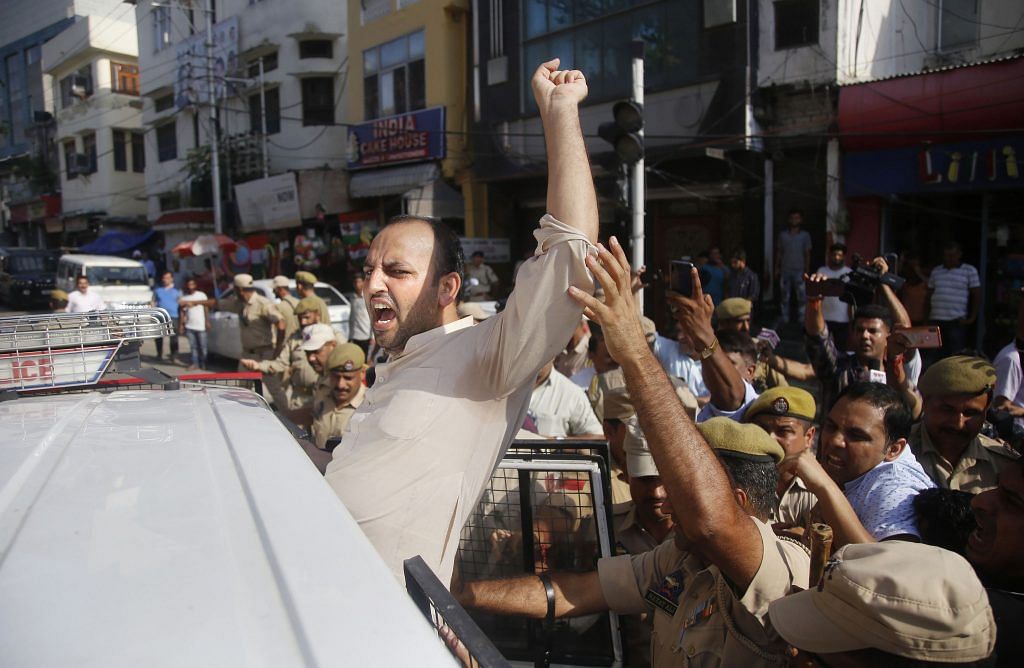New Delhi: Nearly a week after the Modi government imposed a complete communication black-out in Jammu and Kashmir, suspending internet and landline services, images and videos of a widespread protest snuck past the press barricades on the back of international media.
These have now become the bone of contention between the Indian government, which claims there have been only ‘minor’ protests, and the international media houses such as Reuters, BBC amongst others who think otherwise.
BBC had on 10 August published an ‘exclusive video’ that shows large groups of men running and taking cover, while what appears to be the sound of gunfire, echoes in the background.
Smoke rises in the air, and women and men shout indiscriminately in the distance. The scene cuts to thousands flocking the streets carrying posters decrying the revocation of Article 370, and people chant “We want freedom,” and “Go back India!” in unison.
BBC South Asia Bureaux Chief Nicola Careem tweeted that “despite government saying reports of protests in Saura were completely fabricated, see exclusive BBC footage here for the truth.”
WATCH: Despite government saying reports of protests in Saura were completely fabricated, see exclusive BBC footage here for the truth. Thousands marched, police fired on protesters, dozens injured #Kashmir #BBCUrdu pic.twitter.com/J0S72XuK1W
— Nicola Careem (@NicolaCareem) August 10, 2019
“This was shot yesterday at 1530 after Friday prayers in Soura in Srinagar in Indian administered Kashmir,” she said in a follow-up tweet.
To all those saying this is old footage, zoom in to the clip from 2.06 to 2.09 and you will see this banner https://t.co/1TfWNgre5O pic.twitter.com/83L1CT8sBn
— Nicola Careem (@NicolaCareem) August 10, 2019
BBC Sunday issued a statement that its reporting on Kashmir has been objective. “We are covering the situation impartially and accurately,’’ it said, despite “severe restrictions’’ on the ground.
BBC statement on #Kashmir coverage pic.twitter.com/XJfLOrh9nQ
— BBC News Press Team (@BBCNewsPR) August 11, 2019
The BBC video came on the back of a Reuters report, which said over 10,000 people in Srinagar took to the streets to protest India’s decision to scrap Article 370 that stripped the region of its special status. The report, by journalists Devjyot Ghoshal and Fayaz Bukhari on 9 August, said that the “Indian police used tear gas and pellets to fight back,” and that witnesses told them that “some women and children even jumped into the water,” to avoid the onslaught of pellets.
The Indian government officially denied this report.
“A news report originally published in Reuters and appeared in Dawn claims there was a protest involving 10,000 people in Srinagar,” spokeswoman for India’s Ministry of Home Affairs Vasudha Gupta tweeted at 12:20 pm the same day.
“This is completely fabricated & incorrect. There have been a few stray protests in Srinagar/Baramulla and none involved a crowd of more than 20 ppl,” she added.
A news report originally published in Reuters and appeared in Dawn claims there was a protest involving 10000 people in Srinagar.
This is completely fabricated & incorrect. There have been a few stray protests in Srinagar/Baramulla and none involved a crowd of more than 20 ppl.
— Spokesperson, Ministry of Home Affairs (@PIBHomeAffairs) August 10, 2019
More international media flak
Al Jazeera and Washington Post carried similar reports on 9 August, which included a picture by the Associated Press of Kashmiri women protesting after Friday prayers in Srinagar, as well as video footage (Al Jazeera) of hoards of demonstrators carrying black flags, placards and chanting “we want freedom” and “abrogation of Article 370 is not acceptable”.
The reports said that protesters at Soura — an area in Srinagar — suffered multiple injuries and were admitted to two hospitals in the city.
Also read: Haven’t spoken to family in 6 days, how is that acceptable, asks Kashmiri student, moves SC
‘Calm in the Valley’
The Jammu and Kashmir Police, however, still maintains that the situation in the Valley is “peaceful” and that “no firing has taken place in Kashmir over 6 days”.
Press Release.@diprjk @KashmirPolice @igpjmu pic.twitter.com/mDhlKJMYyO
— J&K Police (@JmuKmrPolice) August 10, 2019
In a statement from its official handle posted late Saturday night, the J&K police director general of police Dilbagh Singh “requested people not to believe fabricated and motivated news.”
“There has been no untoward incident barring minor stone-pelting which was dealt with on the spot and was nipped in the bud,” Singh told news agency PTI, and the statement further stressed that “the situation is calm, people are cooperative and restrictions are being relaxed to ease the situation.”
An image of 14-year-old Afshana Farooq by Atul Loke that appeared in The New York Times tells a different story. She lies in pained tears on a stretcher, with her arm in a drip, and a hand on her head for comfort, “after being nearly trampled in a stampede when Indian forces opened fire on demonstrators,” says the caption.
In a series of images under an article titled ‘Photos Emerge From Kashmir, a Land on Lockdown,’ in NYT, Indian migrant labourers can be seen fleeing Kashmir by climbing through emergency train windows, an activist can be seen being forcefully detained by the police in a protest in Jammu, and stone-pelters can be seen in direct conflict with the armed forces deployed in the Valley.
Also read: Twitter, Insta go red: Does display-picture activism make sense when Kashmir is in lockdown?
A version of truth
This is not the first time there have been conflicting versions of events between the Indian government and the international media. A similar scenario played out after the Balakot air strikes in late February.
While India championed its first-ever deep territory counter-attack in Pakistan, with claims from the likes of Home Minister Amit Shah that over 250 terrorists had been killed, Pakistan denied that any such basecamp even existed and that the only thing the Indian aircrafts had managed to damage was some flora and fauna.
Even then, the Indian government’s stance differed considerably from the reports doing rounds in international media.
